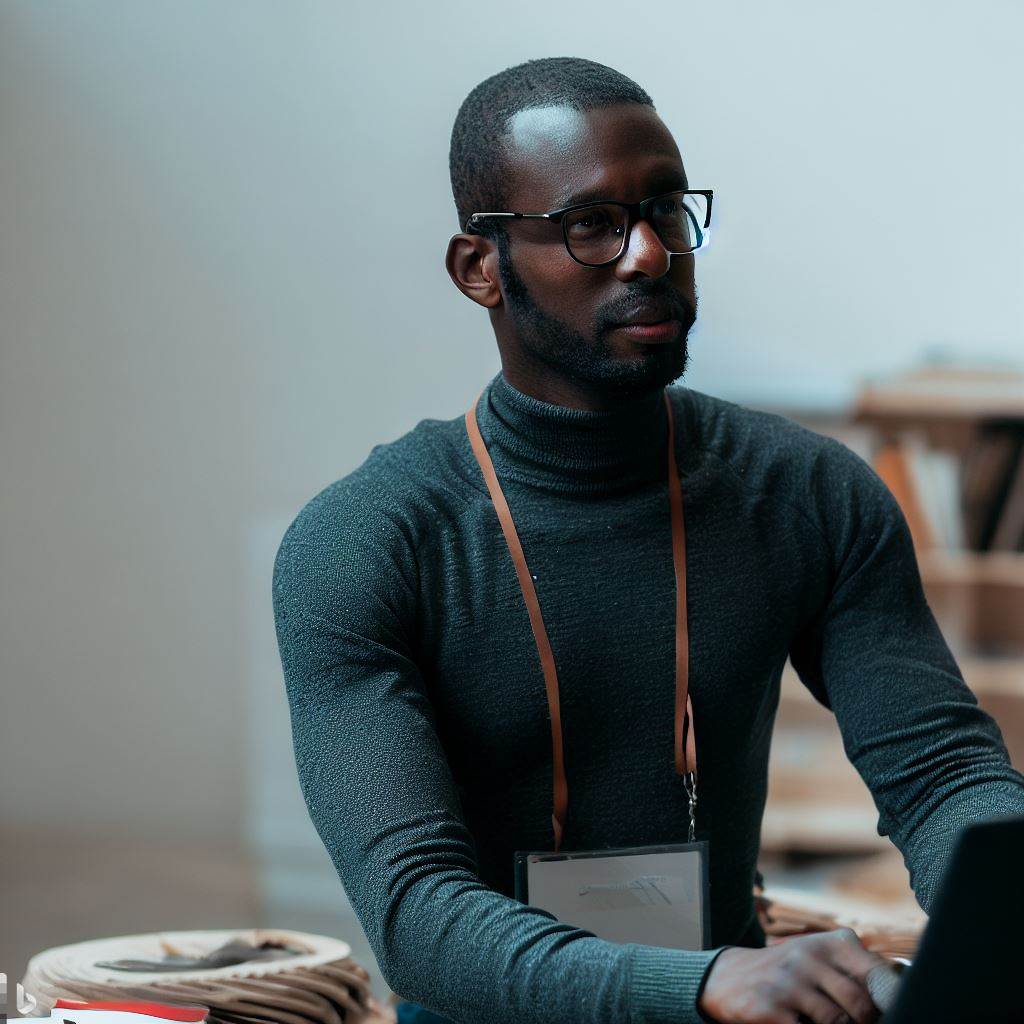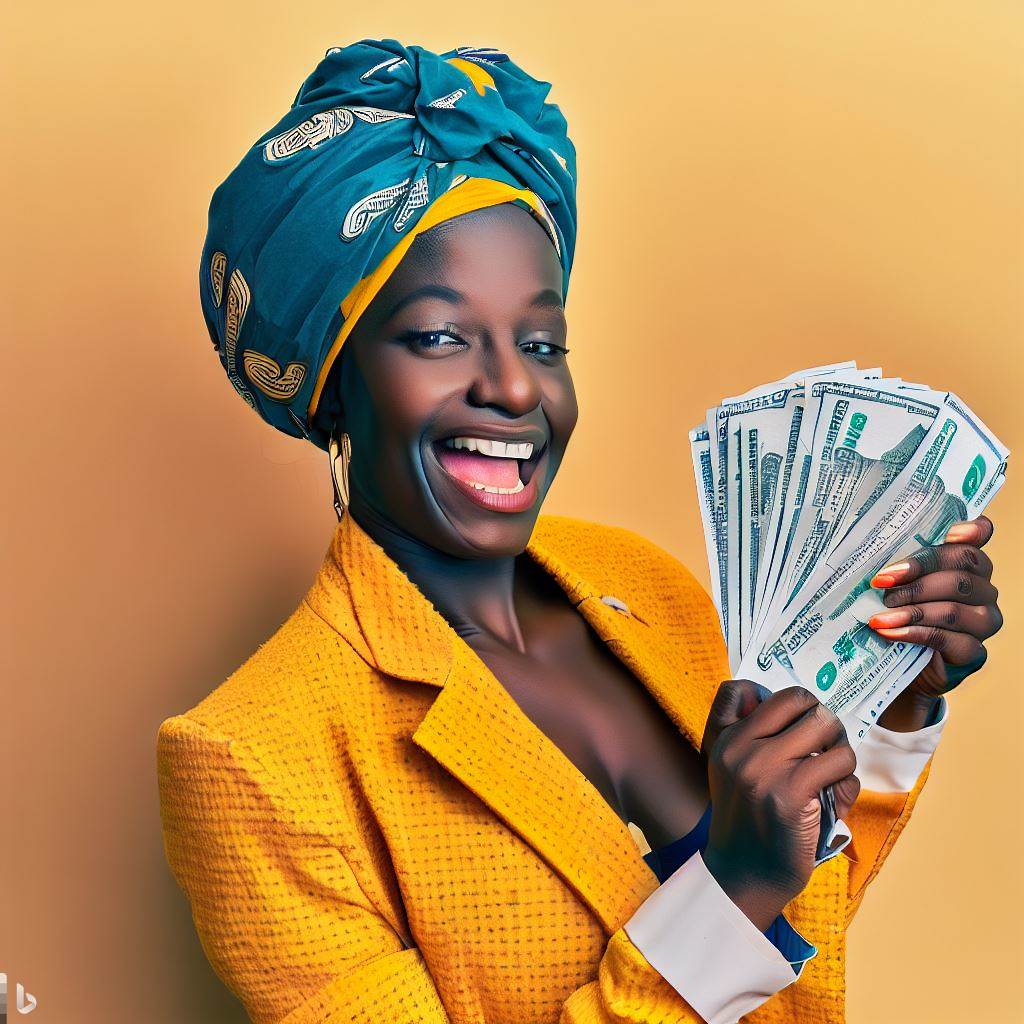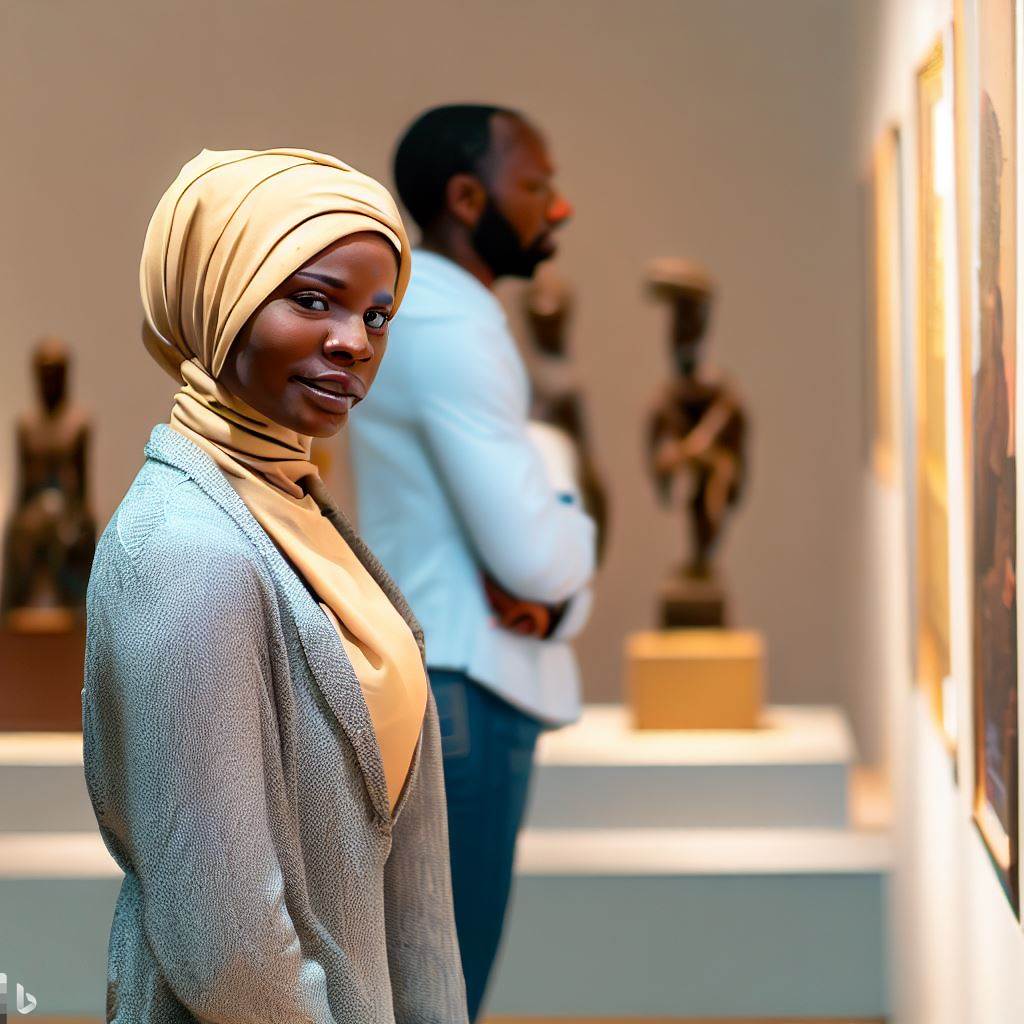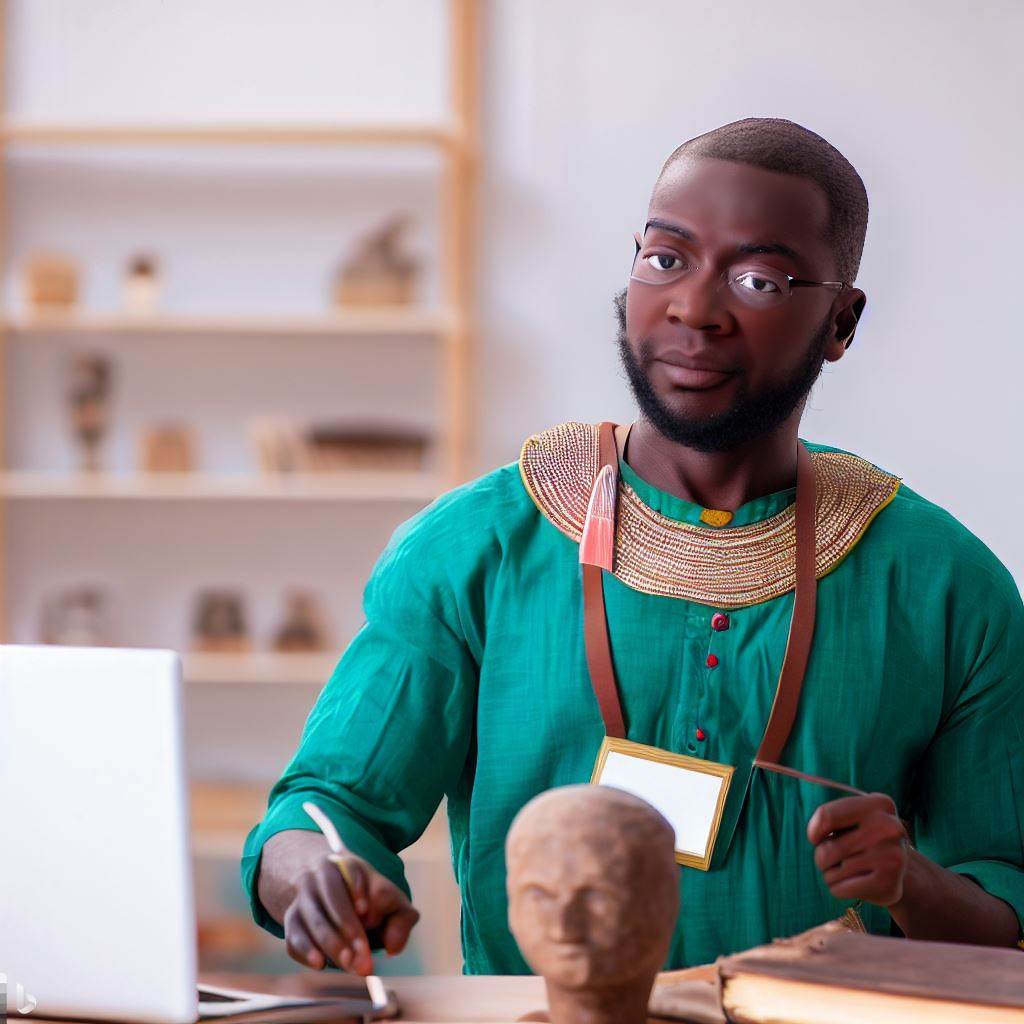Introduction
Curatorial practices in Nigeria have evolved significantly, playing a crucial role in shaping the art scene.
This blog post provides an overview of the evolution of curatorial practices in Nigeria and their importance.
The evolution of curatorial practices in Nigeria is a fascinating journey:
Historical Context:
Curating in Nigeria has transformed over the years, reflecting cultural shifts.
The Significance of Curatorial Practices
- Art Scene Shaping: Curatorial practices have a pivotal role in shaping Nigeria’s dynamic art scene.
- Cultural Preservation: They preserve and showcase Nigeria’s rich cultural heritage.
- Innovation: Curators drive innovation, pushing artistic boundaries and perspectives.
Overview of the Blog Post
This blog post delves into:
- Historical Progression: Tracing the evolution of curatorial practices from the past to the present.
- Curatorial Impact: How curators influence the Nigerian art landscape.
- Challenges and Trends: The challenges curators face and emerging trends in the field.
Understanding the evolution and importance of curatorial practices in Nigeria offers insights into the vibrant and ever-changing world of Nigerian art.
Pre-colonial Era
Traditional Nigerian art and how it was curated
In the pre-colonial era, traditional Nigerian art held immense cultural and spiritual significance.
Curators played a vital role in preserving and exhibiting these artworks, ensuring their longevity and accessibility.
Through their knowledge and expertise, curators carefully curated and organized the art, showcasing its beauty and cultural value.
The curators would often consult with community elders and spiritual leaders to gain insights into the meaning and symbolism behind the art.
The process of curating traditional Nigerian art involved careful selection, documentation, and preservation of artifacts.
Curators employed various techniques to conserve the artworks, such as using natural substances to prevent deterioration and aging.
The preservation and exhibition of art were not solely for aesthetic purposes, but also for educational and spiritual reasons.
Curators acted as custodians of knowledge, passing down stories and legends associated with the artworks to future generations.
Significance of oral tradition in curatorial practices
Oral tradition played a significant role in curatorial practices, as it provided context and background to the art.
Curators would often incorporate storytelling and oral histories when exhibiting traditional Nigerian art.
The use of oral tradition helped to preserve the cultural heritage and ensure the continuity of knowledge surrounding the artworks.
Curators were highly respected individuals within the community, entrusted with the responsibility of preserving the cultural identity.
Their expertise and understanding of art and tradition allowed them to curate exhibitions that celebrated the richness of Nigerian culture.
The curators not only curated art but also played a role in art production, guiding and mentoring artists in their creative endeavors.
They acted as mediators between artists and the community, fostering an appreciation and understanding of the art form.
Curators organized exhibitions and public ceremonies, providing opportunities for the community to engage with the artworks.
These exhibitions served as platforms for cultural exchange and communication, fostering a sense of unity and pride.
The curators’ role extended beyond preservation and exhibition; they also played a part in the documentation of art history.
Through their efforts, they contributed to the scholarship and understanding of traditional Nigerian art forms.
Curators ensured the accessibility of art to the wider community, promoting inclusivity and cultural appreciation.
Their dedication and passion for preserving Nigerian art has paved the way for the evolution of curatorial practices.
As we delve deeper into the evolution of curatorial practices in Nigeria, it is essential to acknowledge the invaluable contributions of curators in preserving and promoting the rich cultural heritage of the country.
Read: How to Get Your First Curator Job in Nigeria
Colonial Era
The impact of colonization on curatorial practices in Nigeria was significant
Colonial powers introduced Western art forms and exhibitions, leading to a shift in the local cultural landscape.
Curatorial decisions were heavily influenced by colonial ideologies, reflecting the dominance of colonial powers.
1. Impact of colonization on curatorial practices
- Curatorial practices changed as Nigeria became a colony of the British Empire.
- British colonial rulers imposed their own cultural values and standards on the Nigerian art scene.
- Indigenous art forms and traditions were marginalized in favor of Western aesthetics and ideologies.
- Local curators and artists had to adapt to the expectations and demands of the colonial administration.
2. Introduction of Western art forms and exhibitions
- Colonial powers brought European art forms, such as painting and sculpture, to Nigeria.
- Western-style exhibitions became popular, showcasing European artworks and concepts.
- Indigenous art forms were often seen as primitive or inferior in comparison to Western art.
- The introduction of Western art forms led to the emergence of a hybrid Nigerian artistic identity.
3. Influence of colonial ideologies on curatorial decisions
- Colonial ideologies emphasized European superiority and the inferiority of indigenous cultures.
- Curators often focused on promoting European artworks and artists instead of local talents.
- Colonial administrators controlled the narrative of Nigerian art, shaping its perception within and outside the country.
- Traditional Nigerian artworks were sometimes collected and exhibited solely for their ethnographic interest.
Despite these constraints, there were also instances of resistance and innovation within Nigeria’s curatorial scene during the colonial era.
Nigerian artists and curators, both influenced by Western art forms and grounded in their indigenous heritage, sought ways to navigate the complexities of the colonial system.
4. Resistance and innovation
- Some Nigerian artists incorporated Western techniques and styles into their works while retaining cultural symbolism.
- Indigenous art institutions, such as the Oshogbo Art School, emerged as spaces to promote local art forms.
- Nigerian curators, like Kenneth Murray of the Nigerian Museum, challenged colonial narratives and championed African art.
- Efforts were made to preserve and document traditional Nigerian art forms amidst Western influences.
Basically, the colonial era had a profound impact on curatorial practices in Nigeria.
The introduction of Western art forms and exhibitions transformed the local art scene, leading to a shift in cultural dynamics.
Curatorial decisions were heavily influenced by colonial ideologies, resulting in the marginalization of indigenous art forms.
However, there were also instances of resistance and innovation, as Nigerian artists and curators navigated the complexities and challenges of the colonial system.
Read: Freelance Curating in Nigeria: Tips and Insights
Post-Independence Era
During the post-independence era in Nigeria, there was a significant emergence of national art galleries and museums.
These institutions played a crucial role in showcasing and preserving Nigerian art and cultural heritage.
1. Emergence of National Art Galleries and Museums
- Nigeria’s newfound independence in 1960 marked a turning point in the development of curatorial practices.
- With a growing sense of national identity, the Nigerian government invested in the establishment of art galleries and museums.
- The National Gallery of Modern Art, located in Lagos, was one of the first institutions to be established.
- Other notable galleries and museums include the National Museum in Lagos, the National Arts Theatre, and the Nigerian National Gallery of Art.
2. Reclaiming Nigerian Cultural Heritage
- Curatorial practices took a significant shift during this era, with a focus on reclaiming and preserving Nigerian cultural heritage.
- Efforts were made to collect, document, and exhibit traditional artifacts and artworks from various Nigerian ethnic groups.
- Curators played a fundamental role in curating exhibitions that highlighted the rich history and cultural diversity of Nigeria.
- By showcasing traditional art forms, these institutions aimed to foster a sense of national pride and promote cultural exchange.
3. Promoting Local Artists and Art Movements
- Curators in Nigeria actively sought to promote local artists and art movements.
- Through exhibitions, workshops, and collaborations, they provided platforms for Nigerian artists to gain recognition and exposure.
- Curators played a crucial role in organizing art events and fostering a supportive environment for artists to thrive.
- They focused on showcasing contemporary Nigerian art, encouraging experimentation, and providing opportunities for artists to connect with international art scenes.
Generally, the post-independence era in Nigeria witnessed the emergence of national art galleries and museums.
Curatorial practices during this time focused on reclaiming Nigerian cultural heritage and promoting local artists and art movements.
Curators played a vital role in preserving and showcasing the nation’s rich artistic traditions, fostering national pride, and providing platforms for Nigerian artists to flourish.
Read: The Influence of International Curators in Nigeria
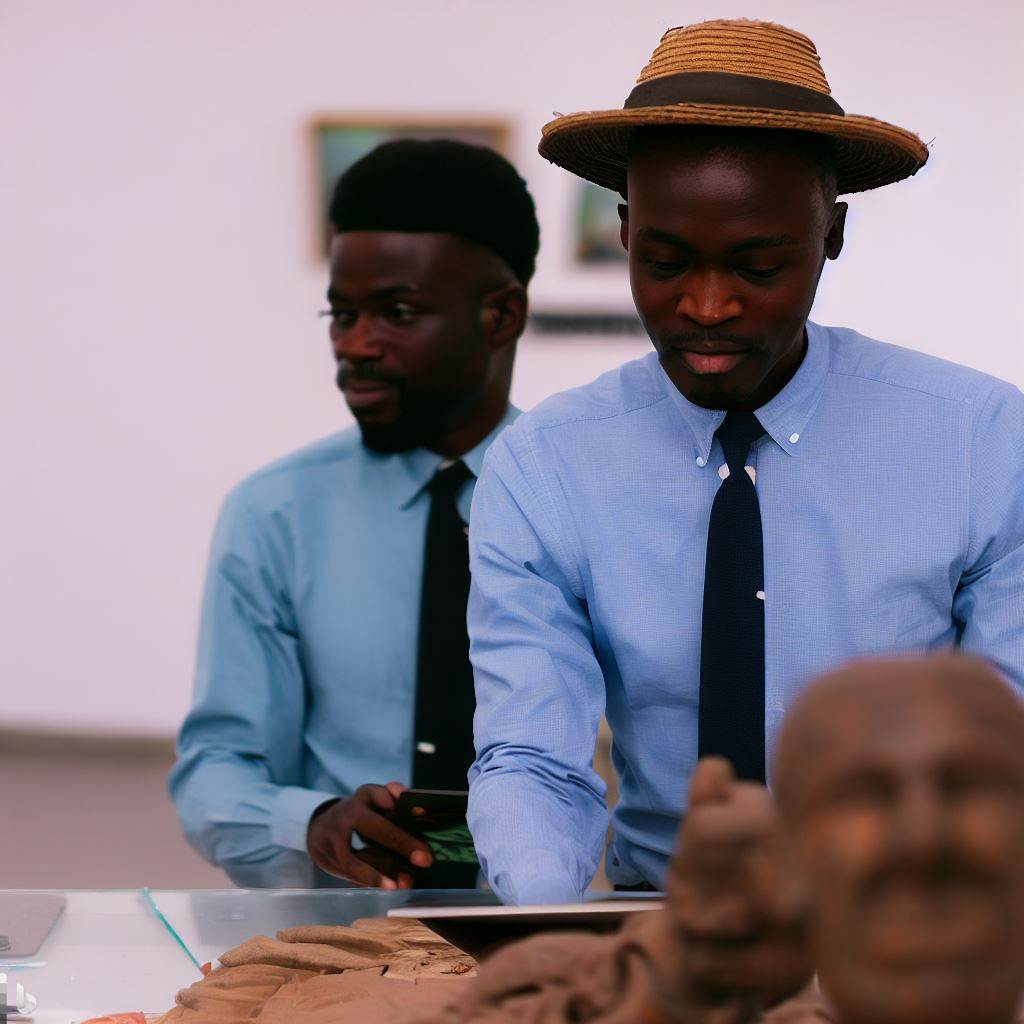
Contemporary Curatorial Practices
In recent years, Nigeria has witnessed a notable shift in curatorial practices, where independent art spaces and alternative models have emerged.
1. Formation of Independent Art Spaces and Alternative Curatorial Models
- Artists and curators have recognized the need for independent platforms outside traditional institutions.
- Spaces like Rele Gallery and Red Door Gallery have provided artists with opportunities to exhibit their work.
- These art spaces have become crucial in fostering experimentation and showcasing emerging talents.
- Alternative curatorial models, such as pop-up exhibitions and site-specific installations, have gained popularity.
- This allows curators to curate art experiences outside the constraints of conventional gallery spaces.
2. Use of Technology in Curating and Showcasing Nigerian Art
- The digital age has greatly influenced curatorial practices and the way Nigerian art is showcased.
- Online platforms like Instagram and Artsy have become essential tools for curators to reach a wider audience.
- Virtual exhibitions and online galleries have gained prominence, especially during the COVID-19 pandemic.
- Curators use technology to curate digital exhibitions that provide immersive experiences for viewers.
- Artists have also embraced technology, using mediums like video installations and digital art to express their ideas.
3. Innovative Approaches to Curatorial Practices
- Curators in Nigeria are exploring new approaches to showcase and engage with art.
- Collaborative exhibitions involving multiple artists or curators have become common.
- Curators are also focusing on public art projects that promote accessibility and community participation.
- Art interventions in public spaces have become a powerful tool for social commentary and cultural exchange.
- Curators are employing cross-disciplinary and cross-cultural approaches in curating exhibitions.
Essentially, contemporary curatorial practices in Nigeria have evolved to embrace independent art spaces, alternative models, and the use of technology.
Curators are exploring innovative approaches to curating, showcasing Nigerian art, and engaging with a broader audience.
These developments contribute to the vibrancy and diversity of the Nigerian art scene.
Read: Women Curators in Nigeria: Breaking Cultural Barriers
Challenges and Future Directions
Challenges faced by curators in Nigeria
In the ever-evolving landscape of curatorial practices in Nigeria, curators face numerous challenges. These challenges include:
- Limited funding for curatorial projects.
- Lack of access to resources and materials.
- Inadequate infrastructural support for exhibitions and installations.
- Bureaucratic processes and red tape in obtaining necessary permits and licenses.
- Limited opportunities for professional development and training.
The need for more inclusive and diverse curatorial practices
Despite these challenges, there is a pressing need for more inclusive and diverse curatorial practices in Nigeria.
By addressing this need, curators can contribute to a more comprehensive representation of Nigerian culture and art.
Some reasons for a more inclusive approach include:
- Representation: A diverse curatorial practice ensures that all voices and perspectives are represented.
- Cultural Exchange: By including diverse artists and artworks, Nigeria can foster cultural exchange and dialogue with other countries.
- Social Impact: Inclusive and diverse exhibitions can challenge societal norms and promote social change.
- Global Relevance: Embracing inclusivity in curatorial practices puts Nigeria on par with international standards.
Potential future directions for curatorial practices in Nigeria
To achieve a more inclusive and diverse curatorial practice, the following future directions can be explored:
- Collaboration: Curators should collaborate with local communities, artists, and institutions to foster a more inclusive approach.
- Education and Outreach: Curators should engage in educational programs and outreach initiatives to cultivate inclusivity in the arts.
- Grants and Funding: Increased funding opportunities specific to curatorial projects can support more inclusive practices.
- Artistic Exchanges: Encouraging international collaborations and exchanges can diversify curatorial practices in Nigeria.
- Research and Documentation: Curators should conduct research to identify underrepresented artists and artworks for inclusion.
By embracing these future directions, curators in Nigeria can make significant strides towards a more inclusive and diverse curatorial landscape.
This will not only enrich the cultural fabric of Nigeria but also contribute to the global dialogue on art and curatorial practices.
In general, the challenges faced by curators in Nigeria are not insurmountable.
With a concerted effort towards inclusivity and diverse curatorial practices, the art scene in Nigeria can thrive, representing the richness and diversity of its culture.
The future holds great potential for curatorial practices in Nigeria, with collaborations, education, funding, exchanges, and research leading the way towards a more vibrant art community.
Conclusion
The evolution of curatorial practices in Nigeria has been remarkable.
Over the years, Nigerian curators have adapted and transformed their approaches to meet the changing dynamics of the art world.
Curating plays a vital role in preserving and promoting Nigerian art.
Through careful selection, presentation, and interpretation, curators contribute to the preservation of artistic legacies and cultural heritage.
They also provide platforms for artistic expression and engage audiences in meaningful ways.
The significance of curatorial practices cannot be understated. Curators serve as mediators between artists and viewers, facilitating dialogue and understanding.
They shape narratives, challenge conventions, and create connections between artworks and their historical and social contexts.
Curatorial practices in Nigeria have expanded beyond traditional spaces, embracing new technologies and interdisciplinary approaches.
This has allowed for the exploration of diverse themes and perspectives, revitalizing the Nigerian art scene and making it more accessible to a wider audience.
As Nigeria continues to produce talented artists and innovative artworks, the role of curators will remain crucial.
They will continue to curate exhibitions, build collections, and collaborate with artists, scholars, and institutions, enriching Nigeria’s cultural landscape and contributing to the global dialogue on art.
In essence, the evolution of curatorial practices in Nigeria has been instrumental in shaping the country’s art scene.
Curating not only preserves and promotes Nigerian art but also fosters cultural exchange and appreciation.
The significance of curatorial practices lies in their ability to showcase artistic diversity, challenge perspectives, and create meaningful experiences for both artists and audiences.

